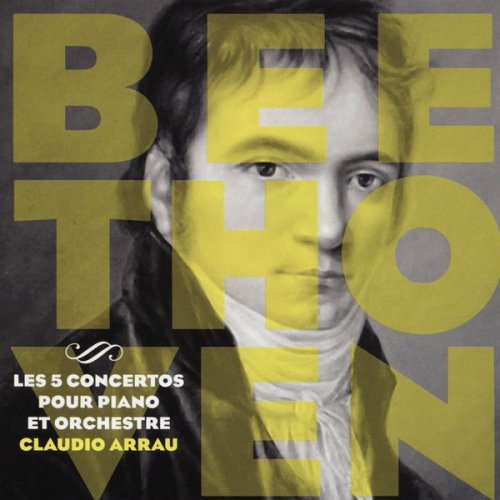Claudio Arrau, Alceo Galliera & Philharmonia Orchestra - Les cinq concertos pour piano et orchestre (2017)

Artist: Claudio Arrau, Alceo Galliera, Philharmonia Orchestra
Title: Les cinq concertos pour piano et orchestre
Year Of Release: 2017
Label: UVM Distribution
Genre: Classical
Quality: flac lossless
Total Time: 03:14:31
Total Size: 760 mb
WebSite: Album Preview
TracklistTitle: Les cinq concertos pour piano et orchestre
Year Of Release: 2017
Label: UVM Distribution
Genre: Classical
Quality: flac lossless
Total Time: 03:14:31
Total Size: 760 mb
WebSite: Album Preview
---------
CD1
01. Concerto pour piano No. 1 in C Major, Op. 15: I. Allegro con brio
02. Concerto pour piano No. 1 in C Major, Op. 15: II. Largo
03. Concerto pour piano No. 1 in C Major, Op. 15: III. Rondo. Allegro Scherzando
04. Concerto pour piano No. 2 in B-Flat Major, Op. 19: I. Allegro con brio
05. Concerto pour piano No. 2 in B-Flat Major, Op. 19: II. Adagio
06. Concerto pour piano No. 2 in B-Flat Major, Op. 19: III. Rondo. Molto allegro
CD2
01. Concerto pour piano No. 3 in C Minor, Op. 37: I. Allegro con brio
02. Concerto pour piano No. 3 in C Minor, Op. 37: II. Largo
03. Concerto pour piano No. 3 in C Minor, Op. 37: III. Rondo. Allegro
04. Concerto pour piano No. 4 in G Major, Op. 58: I. Allegro moderato
05. Concerto pour piano No. 4 in G Major, Op. 58: II. Andante con moto
06. Concerto pour piano No. 4 in G Major, Op. 58: III. Rondo. Vivace
CD3
01. Concerto pour piano No. 5 in E-Flat Major, Op. 73 "Empereur": I. Allegro
02. Concerto pour piano No. 5 in E-Flat Major, Op. 73 "Empereur": II. Adagio un poco mosso
03. Concerto pour piano No. 5 in E-Flat Major, Op. 73 "Empereur": III. Rondo. Allegro
04. Sonate pour piano No. 14 in C-Sharp Minor, Op. 27 No. 2 "Clair de lune": I. Adagio sostenuto
05. Sonate pour piano No. 14 in C-Sharp Minor, Op. 27 No. 2 "Clair de lune": II. Allegretto and trio
06. Sonate pour piano No. 14 in C-Sharp Minor, Op. 27 No. 2 "Clair de lune": III. Presto agitato
Arrau was one of the most highly esteemed performers of the central Romantic piano repertoire, especially for Beethoven, but also for Chopin, Liszt, Schumann, and Brahms. His mother was an amateur pianist who gave him early lessons. He gave his first public recital at the age of five in Santiago, and studied with a teacher named Paoli. The Chilean government gave him a grant to send him to Berlin at the age of seven to study at Stern's Conservatory, where his teacher from 1912 to 1918 was Martin Krause. Teacher and student agreed, by the time the youth was fifteen, that his piano technique and artistic polishing were complete; Arrau never went to another teacher. He had already won the Gustav Holländer Medal and the Ibach Prize, made his Berlin debut to astonished acclaim in 1914, and toured in Germany and Scandinavia during World War I. He returned to Chile in 1921 with a triumphal homecoming concert, and then toured in the Western Hemisphere, coming to the United States for the first time in 1924. In the same year he joined the faculty of Stern's Conservatory. He remained based there until 1940, making several tours and winning major prizes. He made history in 1925 in Berlin with a set of twelve recitals in which he played the complete keyboard works of Johann Sebastian Bach. However, after 1940 he never played Bach in public, on grounds that the works were not suited to the piano. In 1940, he returned to Chile, founding a piano school in Santiago. He settled in 1941 in New York where he made his home thereafter. One of his outstanding qualities was thoughtfulness of his interpretations; his audience got the impression that he had studied the work from every angle. This could be a drawback, occasionally causing him to seem cautious and lacking spontaneity. In 1978 he renounced his Chilean citizenship to protest Pinochet's military regime. He remained one of the most respected and beloved of Chileans among the people of that nation. His return there for a tour in 1984 was one of the greatest musical events in South American history.

![RAS - Rød i Blå (2025) [Hi-Res] RAS - Rød i Blå (2025) [Hi-Res]](https://www.dibpic.com/uploads/posts/2025-12/1765847447_s09xuo23tcu1a_600.jpg)






